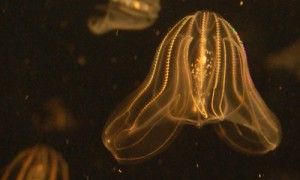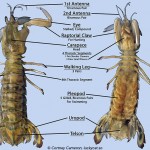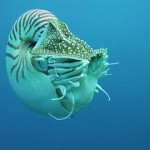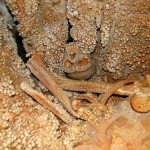Note: This was written for a school project. It will be featured as a chapter in an Apple iBooks textbook released by Duke University about Beaufort marine invertebrates. Image from Wikimedia Commons.
Latin Name: Mnemiopsis leidyi (Sea Walnut)
Taxonomy: Animalia (Kingdom) > Ctenophora (Phylum) > Tentaculata (Class) > Cyclocoela (Subclass) > Lobata (Order) > Bolinopsidae (Family) > Mnemiopsis (Genus)
Habitat & Abundance: Near-surface waters in the Western Atlantic.
Anatomy:
- Clear, gel-like, walnut-shaped body.
- Eight comb rows.
- Two lobes hanging down, flanking mouth.
- Two very reduced tentacles.
Conservation: Not threatened; invasive in some seas.
Description & Fun Facts:
Comb jellies are not jellyfish, even though both phyla feature radial symmetry and gel-like mesoglea-filled bodies (see chart at page bottom). Jellyfish move via muscles that cause their bells to pulse in the familiar manner, but comb jellies use eight rows of beating cilia that gently push them through the water. Jellyfish possess stinging cells (cnidocytes), while comb jellies rely on sticky collocytes to capture food. That means comb jellies don’t sting when handled!
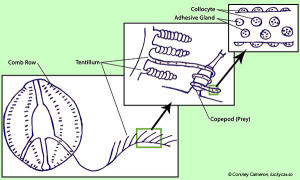 Comb jelly movement tops out at half a centimeter per second. Despite this slow pace, M. leidyi is a notoriously successful hunter of zooplankton, including copepods, small jellyfish, and fish eggs. Motion studies have revealed that the smooth ciliary movement of a comb jelly barely disturbs the water around this predator, making it virtually undetectable to its prey.
Comb jelly movement tops out at half a centimeter per second. Despite this slow pace, M. leidyi is a notoriously successful hunter of zooplankton, including copepods, small jellyfish, and fish eggs. Motion studies have revealed that the smooth ciliary movement of a comb jelly barely disturbs the water around this predator, making it virtually undetectable to its prey.
Light reflecting off of the ever-moving cilia causes comb jellies to emit a striking iridescent rainbow colors along their rows. Comb jellies can also produce bioluminescence using calcium-activated photoprotein-producing photocytes (light cells) that underlie each of its eight cilia rows; when disturbed, sea walnuts will glow greenish-blue.
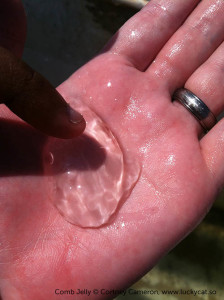 Probably by hitchhiking in ballast waters, sea walnuts invaded the Black, Caspian, North and Baltic Seas, where their voracious appetites depleted plankton levels. However, another type of comb jelly native to the Western Atlantic—the pink comb jelly (Beroe ovata)—happily preys on sea walnuts. Pink comb jellies followed sea walnuts across the ocean, resulting in the stabilization of plankton population levels in invaded areas.
Probably by hitchhiking in ballast waters, sea walnuts invaded the Black, Caspian, North and Baltic Seas, where their voracious appetites depleted plankton levels. However, another type of comb jelly native to the Western Atlantic—the pink comb jelly (Beroe ovata)—happily preys on sea walnuts. Pink comb jellies followed sea walnuts across the ocean, resulting in the stabilization of plankton population levels in invaded areas.
The bodies of comb jellies are very fragile and can be severely damaged when removed from water (during storms, comb jellies sink to depths to avoid harmful currents); therefore, when capturing a comb jelly, it is best to gently scoop the organism into a container with ambient water. Since even small swirling currents can harm the specimen, great care is required.
Comparing the "Coelenterates": Comb Jellies vs Jellyfish
| Ctenophores | Cnidarians | |
| Movement | Cilia | Muscles |
| Hunting | Collocytes | Cnidocytes |
| Development | Tripoblastic | Diploblastic |
| Movement | Cilia | Muscles |
| Tentacles | 2 | Many |
| Symmetry | Biradial | Radial |
References:
- Ruppert, Fox & Barnes. Invertebrate Zoology: A Functional Evolutionary Approach, 7th edition. Brooks/Cole. 2004. Pages 184-195.
- http://archives.thepilot.com/July2004/07-09-04/070904aquarium.html
- Chesapeake Bay Program. http://www.chesapeakebay.net/fieldguide/critter/comb_jellies
- Ruppert & Fox. Seashore Animals of the Southeast. University of South Carolina Press, 1998. Page 55.
- World Register of Marine Species, http://www.marinespecies.org/aphia.php?p=taxdetails&id=158466
- Javidpour, Jamileh; Sommer, Ulrich & Shiganova, Tamara A. (2006): First record of Mnemiopsis leidyi A. Agassiz 1865 in the Baltic Sea. Aquatic Invasions 1 (4): 299–302.
- Kaplan, Eugene. A Field Guide to Southeastern and Caribbean Seashores: Cape Hatteras to the Gulf Coast, Florida, and the Caribbean (Peterson Field Guides). 1999. Pages 219-220. http://books.google.com/books?id=Ekfhub2YU5EC&pg=PA219&lpg=PA219&ots=lm-fmH4_rn&dq=carolina+comb+jelly&output=html_text
- Leitzell, Katherine. Invasion of the ctenophores. 16 Nov 2010. http://earthdata.nasa.gov/featured-stories/featured-research/invasion-ctenophores
- Wagget & Costello. Capture mechanisms used by the lobate ctenophore,Mnemiopsisleidyi, preying on the copepod Acartia tonsa. Journal of Plankton ResearchVol.21 no.11 pp.2037–2052, 1999. http://plankt.oxfordjournals.org/content/21/11/2037.full.pdf
- Colin et al. Stealth predation and the predatory success of the invasive ctenophore Mnemiopsis leidyi. PNAS, vol 107, no. 40, 5 Oct 2010. Pages 17223-17227. http://www.pnas.org/content/107/40/17223
- Schnitzler, Christine E; Pang, Kevin; Powers, Meghan L; Reitzel, Adam M; Ryan, Joseph F; Simmons, David; Tada, Takashi; Park, Morgan; Gupta, Jyoti; Brooks, Shelise Y; Blakesley, Robert W; Yokoyama, Shozo; Haddock, Steven HD; Martindale, Mark Q; Baxevanis, Andreas D (2012). "Genomic organization, evolution, and expression of photoprotein and opsin genes in Mnemiopsis leidyi: a new view of ctenophore photocytes". BMC Biology 10 (1): 107.

